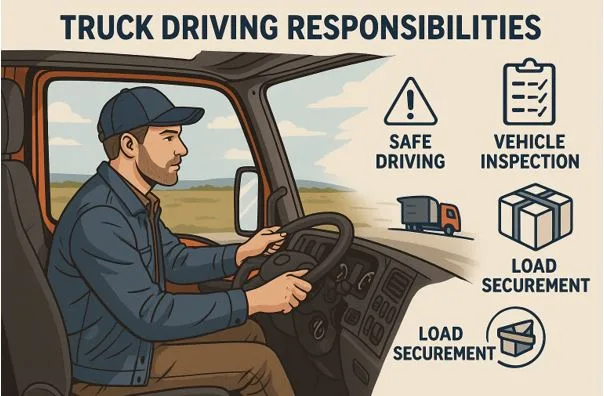Truck Driving Responsibilities: A Deep Dive into the Life of a Professional Driver
Truck drivers are the unsung heroes of the American economy, delivering the goods that keep our businesses running and our lives moving forward. Whether driving across states or making local deliveries, understanding truck driving responsibilities is crucial for anyone considering this essential career. From maintaining a clean driving record to navigating federal laws, today’s truck drivers wear many hats—each with serious accountability.
In this comprehensive guide, we’ll break down the complete truck driver job description, covering everything from pre-trip inspections to delivering cargo safely and on time. If you’re exploring a career in trucking or looking to understand what makes a good truck driver, you’re in the right place.
Understanding Truck Driving as a Career
Becoming a licensed truck driver is not just about sitting behind the wheel. It requires skill, discipline, and a strong work ethic. Many start with a high school diploma followed by enrollment in a professional truck driving school or community college offering training programs aligned with federal regulations.
Key Duties and Responsibilities of a Truck Driver
Let’s explore the core truck driver responsibilities in detail:
1. Operating Trucks Safely and Efficiently
CDL drivers must operate trucks of varying sizes, including tractor trailers, with precision. They must also maneuver large vehicles through city streets, highways, and rural roads while complying with applicable traffic laws.
2. Pre-Trip Inspections
Before hitting the road, drivers must pre-inspect trucks to identify mechanical issues, check brakes, lights, and tires, and ensure overall safe operation of the vehicle.
3. Loading and Unloading Cargo
Most tractor trailer drivers are responsible for loading and unloading cargo—often alongside warehouse workers—and ensuring cargo is secure and undamaged. Those who transport hazardous materials must follow strict safety protocols.
4. Planning Routes and Delivery Schedules
To make deliveries in a safe and timely manner, drivers must plan routes carefully while considering weather conditions, traffic laws, and rest periods as outlined by federal laws.
5. Logging Hours and Documentation
Federal regulations require truck drivers to maintain a detailed log of their working hours, rest breaks, and delivery records. This helps companies monitor safety issues and ensure compliance.
The Role of Truck Drivers in Supply Chains
Truck drivers are essential workers, playing a key role in the nation’s supply chains. From manufacturing plants to retail stores, their ability to verify loads and deliver freight reliably supports every corner of the economy.
Key Qualifications for a Truck Driving Job
Commercial Driver’s License (CDL)
A commercial driver’s license (CDL) is required for any driver operating a tractor trailer or other commercial vehicles. Some companies require additional endorsements for specialized freight, such as hazardous materials or oversized loads.
Physical Fitness and Medical Clearance
A physical exam is typically mandated to ensure drivers are healthy enough to endure long hours on the road and can respond appropriately in emergency situations.
Clean Driving Record
A clean driving record is a common prerequisite, demonstrating a commitment to safety and reliability.
What Makes a Good Truck Driver?
Great truck drivers are more than just skilled behind the wheel. Here’s what makes a good truck driver stand out:
- Excellent time management
- Respect for company policies and road safety
- Ability to identify mechanical problems
- Strong navigation and planning skills
- Good communication with dispatchers and clients
Types of Truck Drivers
There are various categories based on route types and responsibilities:
- Long haul drivers: Cover long distances, often crossing multiple states
- Over the road (OTR): Stay on the road for days or weeks at a time
- Owner operators: Independent drivers who own and operate their own vehicles
- Local drivers: Work in one location or a limited geographic area
- CDL drivers: Handle specialized cargo or vehicle types
On-the-Job Training and Additional Support
While professional truck driving schools offer classroom learning and road testing, many new drivers benefit from on-the-job training provided by most companies. This real-world experience is key to mastering the nuances of truck driving rules, vehicle maintenance, and customer communication.
Working Conditions and Environment
Weather and Road Conditions
Drivers must be prepared to handle weather conditions ranging from snow to extreme heat, each presenting unique hazards.
Long Hours and Isolation
Driving long hours, often alone, can lead to fatigue and mental strain. Rest areas and forced whisper zones offer opportunities for recovery and reflection.
Handling Emergencies
Drivers must know how to respond to accidents, mechanical issues, and cargo problems while maintaining professional composure.
Regulatory Compliance and Safety
Adhering to Federal and Company Policies
Truck drivers must understand and follow federal laws, company policies, and industry-specific safety procedures.
Managing Hazardous Materials
Those transporting hazardous materials must adhere to strict safety regulations and may require special certifications.
Career Advancement and Opportunities
From owner operators to fleet managers, truck driving opens doors to advancement. With experience, some drivers move into roles that allow for shorter hauls, better work-life balance, or supervisory positions.
Labor Statistics and Job Outlook
According to the Bureau of Labor Statistics, demand for licensed truck drivers remains strong. As many drivers retire and e-commerce continues to expand, this field offers stable employment for new drivers entering the workforce.
Support Systems for Drivers
Many companies, like Rapid Response, Inc., offer robust support systems, including additional training, 24/7 dispatch support, and benefits that promote safe and timely deliveries. You can learn more about their driver-first culture on their official website.
Conclusion: The Weight of the Wheel
Being a truck driver is about far more than driving. The duties and responsibilities stretch across safety, logistics, and customer service. As an essential worker, a truck driver must balance rules, expectations, and the physical demands of the job. But for those with grit, resilience, and dedication, it’s a career full of pride, independence, and impact.






